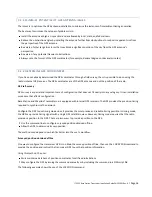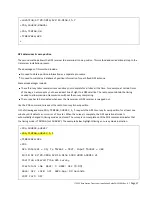
ITC 220 Base Station Transceiver Installation Guide PN 133991 Rev. A
| Page 37
+LOCATION,47:28.381N,122:14.013W,15.7
+POS,SOURCE,MANUAL
+POS,TIMING,ON
+TIMESYNCH,GPS
+
GPS determines its own position
The second method allows the GPS receiver to determine its own position. This method adds an additional step to the
transceiver installation process.
The advantages of this method include:
No need to obtain position information as a separate procedure.
No need to maintain a database of position information for each fixed GPS antenna.
Some disadvantages include:
The self survey takes several minutes and may not complete for all sites all the time. For example, at certain times
of the day, an antenna may not have a direct line of sight to a GPS satellite. The radio cannot obtain the timing
needed to allow precision transmissions without the survey completing.
The survey has to be repeated whenever the transceiver or GPS receiver is swapped out.
Use the
POS
command to request the radio to survey its own position.
In the following example,
POS,TIMING,SURVEY,1,1
requests the GPS to survey its own position for at least one
minute until it detects an rms error of 1 meter. When the survey is complete, the GPS operational mode is
automatically changed to timing mode and stored. The survey is not complete until the POS command indicates that
the timing mode is
TIMING
(not
SURVEY
). The example below highlights timing vs. survey mode indication.
+POS,SOURCE,SURVEY
+POS,TIMING,SURVEY,1,1
+TIMESYNCH,GPS
+POS
GPS Interval = 30, Tx format = TEXT, Input format = UBX
19:18:42 47:28.380N 122:14.015W S000 H000 A00014 V1
Position entered from GPS survey
Precision: LOW NSAT: 9 HDOP: OFF (0.93)
HOLD: OFF LOCK: OFF DGPS-Age: 99 Seconds
COPY Port: OFF
















































